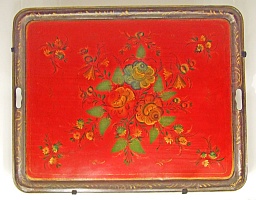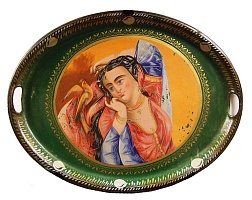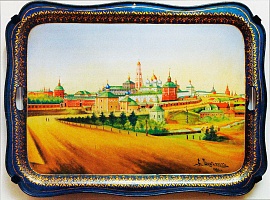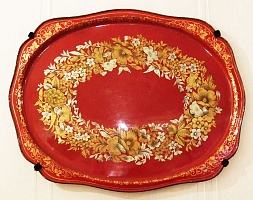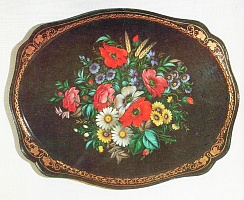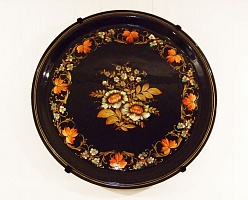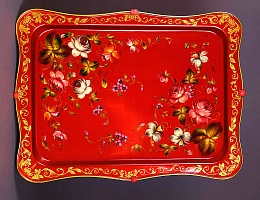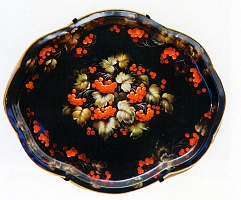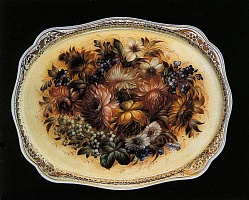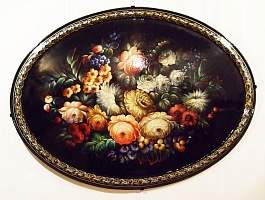Painting on Metal (Zhostovo and Nizhny Tagil Trays)
Painted metal trays, as fashionable interior articles, appeared in Russia in the 18th century. Iron trays with floral painting spread together with a tea-drinking tradition, that eventually became a Russian national custom. The first trays were made at Demidovs’ mining plant in Ural Nizhny Tagil in the first half of the 18th century. The rejected metal sheets were used for tableware, including trays decorated with painting and coated with varnish. Demidovs’ serf Andrei Stepanovich Khudoyarov invented very transparent and unusually durable “crystal” varnish, based on copal resin supplemented with linseed oil and turpentine. Its quality surpassed English and French varnish and approached Chinese lacquer. The early Nizhny Tagil trays were massive and rectangular in shape. They were mainly decorated with genre scenes (tray “Wedding of Peter I” produced by Borodin in 1874) and floral compositions (tray with flowers and tray with still life, 1920s).
Along with Nizhny Tagil the Museum presents another celebrated center – Zhostovo. The Moscow Region tray painting center, known as “Zhostovo”, emerged in the early 19th century. It was associated with the name of Osip Filippovich Vishnyakov. Circa 1825, he founded a workshop, producing snuff-boxes, boxes and trays of papier-mache in Zhostovo village of the Troitskaya volost in the Moscow province (now the Mytishchi district, Moscow region). In the mid-19th century, they began to make metal trays that eventually replaced the products of papier- mache.
Vishnyakov trays were supposed to match tastes of prosperous peasants, lower middle class and merchants. Trays were used not only as serving utensils, they often were elements of interior decoration. The Museum displays a tray with a view of the Trinity-St. Sergius Lavra, produced in 1904 by A. Vishnyakov (who was a monk of the TSL for a long time). There are also exhibited popular trays “Shahs” and “Ladies”. Such trays depicted an “exotic” lady or a militant Shah. The edges were decorated with golden ornaments that formed a kind of frame.
At the turn of the 20th century, the Zhostovo craft went through a crisis. The demand for trays declined, the production decreased, the craftsmen went to other centers. In 1912, the remaining masters organized the Labor Artel in Novosiltsevo village, but it soon broke up. The center revived in the 1920s. At that time several cooperatives were created, and, in 1929, they united into the Zhostovo artel “Metallopodnos”. In the 1930s, the folk handicrafts were greatly supported by the Soviet government. Experiments were carried out in handicraft manufacturing. At that time trays were produced on industrial basis, large batches of trays were sent abroad.
The collection of the Sergiev Posad Museum-Reserve preserves the works of the 1930s, that passed from the artel “Metallopodnos” in 1950. They are works of the leading artists: I.S. Leontiev, A.I. Leznov, P.S. Kurzin. The works of A.P. Gogin occupy a special place in history of Zhostovo. In 1920s, he took part in organization of the “Metallopodnos”. For a long time he was an art director there. He created his compositions against colored and silvery backgrounds in contrast to traditional black trays. The exhibition, organized in the State Tretyakov Gallery in 1937, was a very important event for Zhostovo. P.C. Kurzin, D.D. Kuznetsov, I.S. Semenov and V.F. Kulikov made portals that decorated entrances to the exhibition halls.
In 1960, the artel “Metallopodnos” was renamed to “ The Zhostovo Factory of Decorative Painting”, and a new period in its history began. The factory building was reconstructed, the equipment was modernized, a new painting shop was opened. But, despite the technical re-equipment, the center retains its most precious quality: it is still a handicraft. The most important operation, requiring creativity, is painting performed in several steps. The painted tray is coated with varnish and when the layer gets slightly dry, ornaments are painted on the rim. The ornaments are usually accomplished by women-masters.
The Museum exhibits works of the leading artists of the 1960s- 1990s. They are trays of B.V. Grafov, N.N. Goncharova, N.P. Antipov, V.I. Letkov, E.P. Lapshia, N.N. Mazhayev, M.P. Saveliev and others. The trays are of different shapes: round, oval, “Siberian” rectangular with slightly rounded corners, guitar-shaped and figured with scalloped edges. The most frequent motif of Zhostovo painting is a central bouquet framed with a golden border ornament. The smooth black or colored background occupies a lot of space in compositions. The refined inlaid trays look like jewelry.










